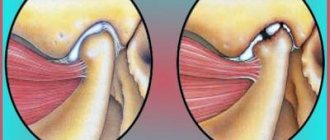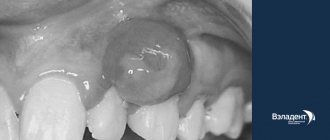Etiology and forms
Fluorine is an essential element of mineral metabolism, participates in hematopoiesis, the formation of bone tissue and teeth, prevents the development of caries, and also ensures the removal of heavy metal salts from the body. The chemical compound enters through the respiratory tract, skin and digestive tract. Fluoride accumulates in the body and accumulates in teeth, connective and bone structures.
The disease is occupational or endemic in nature, that is, it is characteristic of a certain geographical area. There are also five main forms of mild, moderate and severe:
- spotted;
- dashed;
- chalky-speckled;
- erosive;
- destructive.
Fluorosis affecting the first set of teeth in children is rare and in most cases goes away on its own when temporary units are replaced with molars. Pathological changes, as a rule, occur during the eruption of permanent teeth in children living in areas with increased concentrations of the chemical element in water. With a pronounced degree of fluorosis, the risks of carious processes are high.
Classification
Based on anthropogenesis, fluorosis is divided into endemic and occupational. Although the clinical manifestations of both types of disease are similar, the treatment approach is different. In the professional form of the disease, not only tooth enamel is affected, but also bone tissue, and osteosclerosis and osteoporosis develop. As the disease progresses, disorders of the vascular system and liver occur, and the risk of developing osteosarcoma increases many times over. In this case, fluorescent spots on the enamel layer are often absent.
Forms of fluorosis:
- spotted;
- dashed;
- erosive;
- chalky mottled;
- destructive.
Spotted and streaked fluorosis is a mild type of pathology, erosive and destructive are classified as severe. A patient can be diagnosed simultaneously with different forms of the disease - different clinical pictures are observed on individual dental units and groups of teeth.
Causes of the disease
The main cause of pathological changes is an excess of fluoride in the body. The optimal concentration of a chemical element is considered to be 1 mg/l; if mineralization indicators are exceeded, there is a high probability of developing fluorosis and structural defects. Fluorine easily undergoes substitution reactions and such transformations are not always benign for the body. The hard tissues of teeth are especially sensitive, and the crystal structure and strength of the protective coating are disrupted. A deficiency of a microelement is no less dangerous than an excess and entails growth retardation, defects and deformations of teeth, and pathologies of the skeletal structure. In addition, among the main reasons for the development of fluorosis are:
- eating plant and animal products with an excess of fluorides;
- irrational use of cleaning pastes and rinses enriched with microelements;
- increased fluorine content in the air (factories producing glass, metals, ceramics, optical and laser devices);
- living for a long time near industrial enterprises.
Children under fifteen years of age are at increased risk, which is explained by insufficiently strong enamel, unstable hormonal levels and lack of adequate oral hygiene.
Pathogenesis
During normal enamel formation, matrix proteins (ameloblastin and amelogenin) are gradually replaced by growing hydroxyapatite crystals. The space between adjacent enamel prisms is minimized.
When there is an excess of F- ions, they are more quickly incorporated into the crystal lattice than the larger and asymmetric OH- ions. Fluoridated enamel preserves matrix proteins. As a result of incomplete crystal growth, significant spaces remain along the periphery. The penetration of food pigments turns these cavities brown. Porosity of enamel in severe forms of fluorosis contributes to the spread of caries and increases the risk of chipping from mechanical stress.
Main symptoms of fluorosis
Fluorosis, which occurs due to an excess of fluoride in water and food, appears as white spots or stripes on the cheek surface of the teeth. A characteristic symptom is the lack of shine of the enamel and increased sensitivity to the effects of hot and cold food. As the disease progresses, the teeth acquire a yellow-brown color; the incisors of the upper jaw are most susceptible to changes. In the case of a significant excess of fluorine in water, the process is widespread, which is manifested by damage to symmetrical units, chips, erosions, and abrasion of the enamel. The clinic depends on the form and nature of the disease, the severity of the manifestations.
- With mild fluorosis ( striated and spotted ), chalk marks or stripes are visualized on the incisors, merging into whitish spots. In most cases, changes are barely noticeable and are detected randomly during a medical examination. The lesion covers no more than 25% of the crown; positive dynamics are observed with treatment.
- Finely speckled fluorosis is classified as moderately severe, with the tooth surface having a matte or yellowish tint without a natural shine. Characteristic are clearly defined brown spots and pits with a diameter of up to 1.5 mm, rapid erasure of the natural coating to a dark brown dentin layer.
- With erosive fluorosis, erosions are added to the spots and stripes, while in the area of damage there is pronounced abrasion or complete absence of enamel. There is also a painful reaction to temperature exposure.
- Severe destructive degree is accompanied by destruction of the protective layer and hard tissues. The crown part becomes fragile, susceptible to breaking and chipping, and the tooth takes on an atypical shape. X-ray examination reveals deep defects, and increased sensitivity to temperature stimuli.
Occupational fluorosis is manifested by tooth decay, while the characteristic symptoms are increased sensitivity to temperature stimuli, dark or whitish spots, streaks and dimples on the enamel may be absent. At a late stage of the disease, osteoporosis occurs, joint mobility is limited, and functional disorders of vascular tone are noted. Fluoride has a destructive effect on the parathyroid glands, which leads to impaired secretion of parathyroid hormone and high concentrations of calcium in the blood.
The appointment includes consultation and drawing up a treatment plan with cost determination
sign up for a free consultation
Not ready for an in-person consultation with a doctor? Ask your question by phone
Diagnosis of dental fluorosis
High-quality differential diagnosis is the key to successful treatment and determination of adequate therapeutic tactics. The professionalism of the dentist is important; based on the results of a visual examination, clinical symptoms and anamnesis, he can determine the form and extent of the disease at the first appointment. A dental examination is carried out according to a standard procedure.
- Mild cloudiness of the enamel is detected by drying the surface, which makes it possible to assess the condition of the protective coating in the area of pigmentation changes.
- The vital staining technique is effective - in case of fluorosis, damaged areas of enamel are not exposed to methylene blue dye.
- Determination of the degree of dental damage is carried out using luminescent diagnostics. A mild form of the disease in ultraviolet rays manifests itself as a weak glow; with moderate and severe degrees, partial quenching of fluorescence is observed.
- To exclude caries, microradiography is prescribed. The study also allows us to determine the depth of the lesion in the middle and deep layers of dentin.
Changes in enamel pigmentation may be associated with other pathologies or a lack of vitamins D and A. In this case, the condition of connective tissues worsens, bone fragility, a tendency to inflammatory processes in the gums and roughness of the surface of the teeth are noted.
Basic treatment methods
Therapeutic tactics depend on the form and clinical manifestations of the disease. In addition, the patient must send the water he consumes for laboratory analysis, which determines the percentage of microelements.
For mild cases, local treatment and bleaching (laser, LED or chemical) followed by remineralization are effective. For these purposes, medicinal solutions containing calcium and phosphorus compounds are applied to tooth enamel by application or electrophoresis.
The course of treatment consists of 10-15 procedures. Replacement therapy optimally compensates for the loss of minerals from tooth enamel. In addition, long-term use of calcium gluconate and glycerophosphates is prescribed. The treatment has a lasting effect, however, to consolidate the positive dynamics, repeated courses of therapy are recommended after 8-10 months.
Brown or yellow spots with moderate damage are removed using microabrasion. The procedure is performed by a doctor and involves applying a paste containing acid and abrasive particles. One or two procedures are enough to solve the problem.
In case of pronounced defects and destruction of hard structures, the shade and shape of the crown part is restored with photocomposites, orthopedic structures, porcelain or ceramic onlays (veneers or lumineers). In some cases, pins are used to secure teeth.
Forecast and prevention of the disease
Fluorosis is a dangerous pathological condition; a favorable prognosis is possible with timely detection of changes and adequate treatment. Advanced cases are difficult to treat, but if you follow medical recommendations, it is possible to stop destructive processes, reduce the fluoride content in the body and prevent tooth decay.
The main method of prevention is to replace the source of water with a high content of microelements. For these purposes, it is recommended to install barrier filters with several stages of purification; the use of bottled water is also allowed. An integrated approach is justified, therefore the following preventive measures are recommended:
- exclusion from the diet of fish, seafood, animal fats, tea, coffee and products with dyes;
- daily oral hygiene with cleaning products that do not contain fluoride compounds;
- proper nutrition with a predominance of protein and fiber;
- course intake of multivitamin complexes and calcium supplements.
People predisposed to fluorosis and living in areas where the water contains excessive concentrations of trace elements should visit the dentist at least twice a year.
FAQ
How to treat fluorosis in children?
If your child has fluorosis, treatment options are much the same as for adults. Yellow stains on children's teeth and other manifestations of the disease are eliminated using whitening procedures. Be sure to eliminate the source of increased fluoride.
In addition, children do not undergo restoration, as well as prosthetics and installation of veneers. If we are talking about baby teeth, then such events are pointless, because permanent teeth will replace them.
Fluorosis in children: photo
What happens if fluorosis is not treated?
Pigmentation on teeth is far from the only trouble with fluorosis. If the disease is not treated, it progresses, until the complete loss of the tooth. When the first symptoms of the disease appear, it is extremely important to consult a doctor and undergo treatment.
Is it possible to whiten teeth with fluorosis?
This procedure can be carried out in the initial stages of the disease, when no more than 25% of the enamel is affected. Whitening is carried out to restore the previous aesthetics. It must be remembered that without eliminating the cause of the disease, such an event is meaningless. This way you will only temporarily regain the lost whiteness of the enamel, because if you continue to take fluoride in large quantities (with water, food or medicine), the disease will not go away.
How to avoid dental fluorosis?
To ensure that bones and teeth do not experience problems associated with an excess of fluoride, it is important to monitor the composition of drinking water. In regions where water has high levels of fluoride, people should be informed about this. Don’t be lazy – take an interest in this question. If you buy drinking water, ask for certificates certified by experts that indicate the chemical composition. Normally, 1 liter of drinking water contains from 0.5 to 1 milligram of fluoride.











